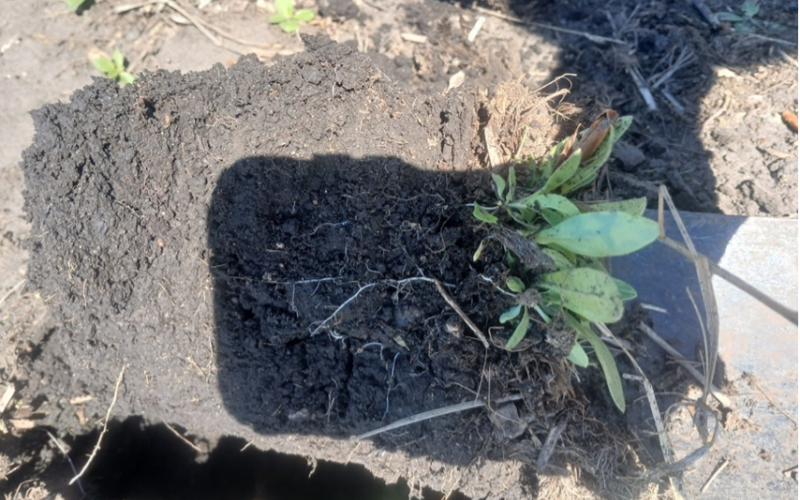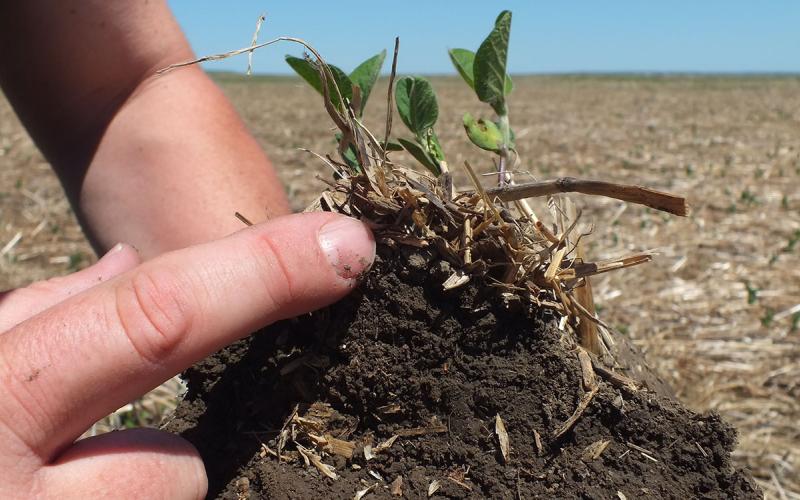Introduction
Salts are present in soils and ground waters. In climates with adequate amounts of rainfall, salts are generally washed below the plant root zone. However, in semiarid or arid areas, salts may not be washed downward from the soil surface. In some areas, salinity in soils is from parent material that soil has formed from or near surface ground waters. Movement of water by capillary action can bring salts from ground water up to soil surface. However, in agricultural production, soil salinity and alkalinity can be caused by using irrigation waters that contain soluble salts or by planting crops in areas that are not very efficient at using water. Having inadequate use of water can lead to more evaporation than evapotranspiration, which leads to salts accumulating near the surface. A picture of a spot where salts have accumulated near the surface is shown in Figure 1 below.
Soil Salinity, Alkalinity and Sodicity Terminology
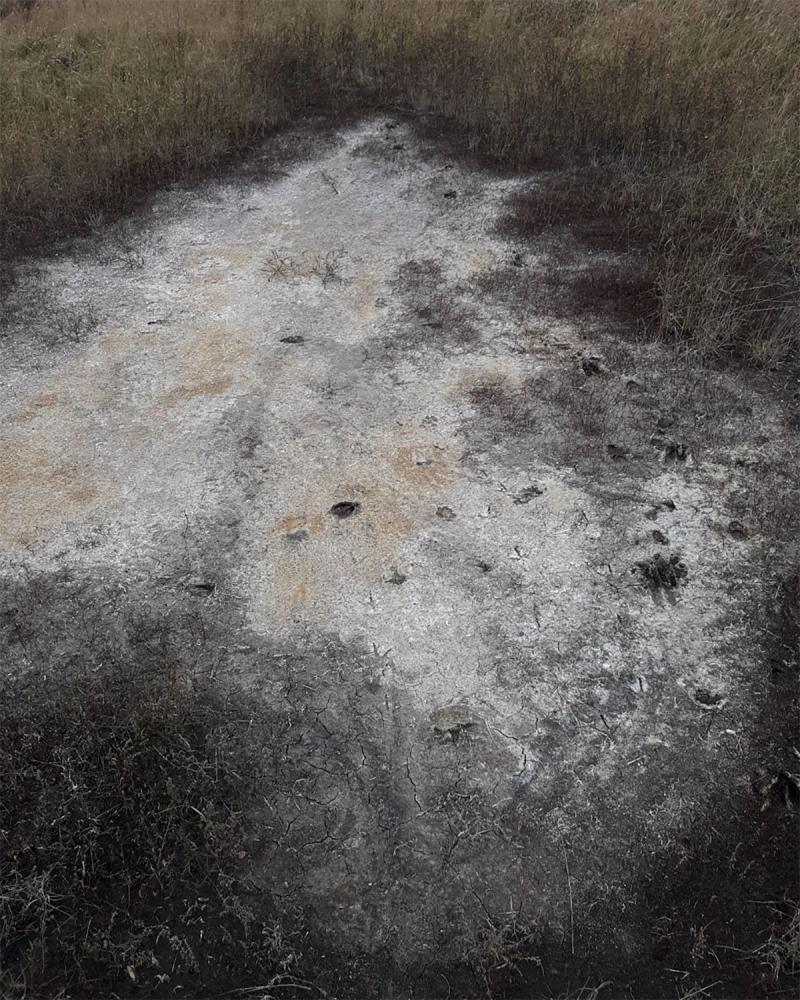
Soil salinity means that the soil is high in soluble salts. The salts that make up the soil solution come from a variety of positively charged cations and negatively charged anions. Too much salt present in the soil can lead to plants taking up excessive levels of certain elements and makes it more difficult for plants to uptake water and essential plant nutrients. There is about the same amount of charge from cations and anions present in the soil. Alkalinity is the ability of the water or soil solution to buffer against acidic solutions. Carbonate, bicarbonate and hydroxide present in the water solution affect the alkalinity of the solution. The term alkalinity is frequently misused as a term for sodicity or salinity. If the soil has a high level of alkalinity the pH is higher than 7. Under high soil pH, nutrients in the soil may be in forms that are not available to plants and cause reduced plant growth. Sodicity is a condition where there is a high proportion of sodium in the soil solution and adsorbed to exchange sites on soil clays and organic matter compared to calcium, magnesium, and other cations. Sodicity is determined by measuring the sodium adsorption ratio or exchangeable sodium percentage. Sodium adsorption ratio is the concentration of sodium molecular charge compared to the charge of calcium + magnesium present in the solution. Sodium adsorption ratio can be measured on soil solution extracts and also on ground or surface waters. Sodium absorption ratio is the ratio of sodium to calcium and magnesium that is dissolved in solution. Exchangeable sodium percentage is the percent of exchangeable cations that occur as sodium compared to other cations (calcium, magnesium and potassium). Exchangeable sodium percentage is an indicator of the amount of sodium absorbed to cation exchange sites. Sodic soils usually have degraded structure, and water flows through them slowly. Sodic soils generally have prismatic or columnar structure, high pH and the sodium levels are usually highest in the B horizon. Sodium disperses soil clays and causes them to move downward from the A to the B horizon. Classification of sodium and salt affected soils is shown in Table 1. However, some soils may have negative effects from sodium when saturated paste extract or exchangeable sodium percentage value is as low as 6. Soils with an expansive clay mineral called smectite or montmorillonite are most susceptible to sodic conditions. This type of clay mineral has the greatest potential for increased swelling/expansion and dispersion in the soil when soil solution sodium is high. Clay dispersion causes soil structural units to break down when wetted, causing soil pores to close and restricting water infiltration and movement within the soil profile. Swelling of clays causes the size of minerals to increase when wet, which blocks soil pores, also reducing water infiltration. Smectite is one of the most-common minerals in soil clays in South Dakota, which is partially why soils in South Dakota are highly susceptible to sodic conditions.
| Soil Type |
Electrical Conductivity (dS m-1) |
Adsorption Ratio |
|
Sodium Percentage (%) |
|---|---|---|---|---|
| Not Salt Affected |
|
|
|
|
| Saline |
|
|
|
|
| Sodic |
|
|
|
|
| Saline-Sodic |
|
|
|
|
*Values are from Brady and Weil 1999.
Salt Types Naturally Occurring in the Soil
The term salt is generically used and is considered to be all minerals that are precipitated as cations and anions together that will dissolve in water. When most people think of salts, they most commonly think of table salt (sodium chloride). However, there are many different cations and anions that are contained in soil solutions, ground and surface waters. Common cations are calcium, magnesium, sodium, and potassium and anions are sulfate, chloride, nitrate, bicarbonate, and carbonate. Many of these are essential plant nutrients (calcium, magnesium, potassium, nitrogen, sulfur, and chlorine), but some of these have negative effects on crop production when at high levels. Common salts in soil include calcite (calcium carbonate), gypsum (CaSO4), Glauber’s salt (sodium sulfate), and Epsom salt (magnesium sulfate).
Sampling Salt and Sodium Affected Soils
In many places in South Dakota only portions of fields have salt or sodium issues. Taking a composite soil sample from the field will only show you the average electrical conductivity, exchangeable sodium percentage, or sodium adsorption ratio across the field. The levels may not be high if portions of the field are productive soils. If you are concerned about a portion of a field having salinity or sodicity issues, a composite sample should be taken from multiple spots in the area where issues are thought to be occurring, then composited. These areas commonly occur in low areas of the fields or along road ditches, where salts can move into the field because of water flow from the wetter areas. Sodium in the soil may be contained in subsurface depths. To determine if there are sodium issues in a field, sampling from multiple depths, such as 0 to 6, 6 to 12 and 12 to 24-inch depths may be necessary to determine where sodium is an issue. Electrical conductivity measured from a saturated paste extract or 1:1 soil: water suspension can identify high soil soluble salts but not sodicity. Sodicity is determined from measuring the exchangeable cations present in the soil or levels of calcium, sodium, and magnesium present in a saturated paste or soil: water extract.
Measuring Salinity and Sodicity for Irrigation Water Management

Certain labs or publications measure salinity and sodium levels with different methods. The best method to measure soil salinity and sodium percentage of the soil solution is saturated paste extract. To do this the soil is mixed with deionized water until it is saturated. Water contents at saturation can widely vary depending upon soil texture and clay types that are present in the soil. Once the soil is saturated, water is extracted from the soil and water mixture, and electrical conductivity, pH, and cations and anions present in the water solution are measured. Electrical conductivity is how well the solution conducts electricity, which increases as the amount of dissolved salts in the soil increases. This is commonly measured in labs due to it being able to be measured quickly. Measuring the level of cations and anions present in soil solution involves using instrumentation, such as atomic adsorption, ion chromatography, and inductively coupled plasma mass spectrometry to determine levels of the different cations and anions. Salinity levels and pH also can be measured on soil: water suspensions of different ratios. The most common soil: water suspension ratio is a 1:1 soil: water suspension. The 1:1 soil: water suspension pH and electrical conductivity is commonly measured as routine soil analysis. Some places also report salinity levels measured on a 1:2, 1:2.5, and 1:5 soil: water suspension. Water also is sometimes separated from these suspensions, and cations and anions can be measured on these extracts. If there are salts that are moderately soluble, such as gypsum or calcite, present in soil, the ratio of sodium/calcium and electrical conductivity might not correlate well to saturated paste extract due to dissolution of these salts into the soil and water suspension.
To identify if the soil is sodic, it can be done by determining ratio of sodium to calcium+ magnesium in the water and/or percent of exchangeable cations that are sodium. Exchangeable sodium percentage is measured by using an extractant to remove the cations that are adsorbed to the exchange sites on soil clays and or organic matter. Then level of cations present in the soil is commonly measured by atomic adsorption or inductively coupled plasma mass spectrometry. Exchangeable sodium percentage is the percentage of extractable soil cations that are sodium. To identify the degree of sodicity in the irrigation water, the cations present in the water are measured. The ratio of sodium to calcium + magnesium (SAR) in the water is calculated. If water has a high SAR (>6), it is likely to cause sodicity in the soil from long-term use of the water. Alkalinity in the water is measured by titrating with an acidic solution until water or soil solution has a neutral pH. Solutions with a higher alkalinity may increase soil pH from long term use.
Importance in Testing Irrigation Waters
Understanding water quality is very important for preventing soil sodicity, alkalinity, or salinity from occurring. This can be done by obtaining a water sample and sending it to a laboratory for irrigation water analysis. Irrigation water analysis shows the amount of cations and anions that are present, as well as alkalinity, pH, and electrical conductivity. Measuring electrical conductivity can be done individually and gives an indication of the total dissolved salts present in the water but not actual levels of different cations and or anions. Irrigation water pH shows the level of acidity present in the water or soil. Higher water pH would indicate a greater amount of alkalinity that is present in the water. In South Dakota, the pH of ground waters is generally 7 or greater. However, rainwater may have an acidic pH, but generally has a lower concentration of cations and anions compared to many ground or surface waters. If water has a high SAR >6 or electrical conductivity value >2 dSm-1 it may cause sodium and salt issues in the soil. Waters with high SAR can degrade soil structure and reduce infiltration of water into the soil. Using water with high concentration of salts (high EC) can lead to increased salinity in the soil and reduced plant growth.
Salinity Tolerance of Plants
Not all plants have the same salinity tolerance. If soils have high salinity levels, especially in dryland agriculture, selection of salt-tolerant plants may be a wise production. Salinity tolerance of some commonly grown crops in South Dakota is shown in Table 2 and Table 3. If you are interested in the salinity tolerance of other commodity crops and vegetables, you can find them in a Plant Salt Tolerance publication by Grieve et al., (2012). The salinity values shown in Table 2 are based off saturated paste EC value. If EC of 1:1 suspension is less than 1 dSm-1 there likely will not be decreased productivity due to salinity. If 1:1 EC is between 1 and 2 dSm-1 sensitive crops to salinity will be affected. If 1:1 soil: water suspension EC is greater than 2 dSm-1 most crops will be affected due to salinity issues. The threshold EC is the saturated paste EC value where the yield begins to decrease. The slope is how much yield will decrease for a 1 unit increase in soil saturated paste electrical conductivity. These numbers and equations have been passed down from old publications and may have been done in hydroponic systems and therefore should only be used as a guide. Depending upon salt types in the soil and at what depths they occur, there may be differing responses to salinity at specific locations compared to guideline numbers. Also, some varieties of crops are more salt tolerant than others. Plants growing in and around saline field areas increase water uptake and are essential at keeping the salt issues from worsening. Planting crops that have low salinity tolerance in salting field areas does nothing more than promoting undesirable weed growth, and more water will move up to surface, bringing more salts and worsening the situation. Evaporation will lead to salts precipitating near surface. Having salt-tolerant plants there that use water will have more water lost through evapotranspiration through the plant instead of evaporation, and the salts will remain a few feet below the surface.
| Crop |
(Ece dS/m) |
per dS/m Increase |
Tolerance Rating |
|---|---|---|---|
| Corn |
|
|
Moderately Sensitive |
| Soybean |
|
|
Moderately Tolerant |
| Wheat |
|
|
Moderately Tolerant |
| Oats* |
|
|
Moderately Tolerant |
| Barley |
|
|
Tolerant |
| Triticale |
|
|
Tolerant |
| Rye |
|
|
Tolerant |
| Canola |
|
|
Tolerant |
| Sorghum |
|
|
Moderately Tolerant |
| Field Pea |
|
|
Moderately Sensitive |
| Alfalfa |
|
|
Moderately Sensitive |
*Measured by EC saturated paste extract (Ece). Numbers are from Grieve et al., (2012). From Carlson et al., (2015)
| Crop |
Salinity (dS/m) |
|
|
|
|
|---|---|---|---|---|---|
| Alfalfa |
|
|
|
|
|
| Barley |
|
|
|
|
|
| Canola |
|
|
|
|
|
| Corn |
|
|
|
|
|
| Field Pea |
|
|
|
|
|
| Oats |
|
|
|
|
|
| Rye |
|
|
|
|
|
| Soybean |
|
|
|
|
|
| Sunflower |
|
|
|
|
|
| Wheat |
|
|
|
|
|
* Measured by 1:1 soil: water suspension with EC 1:1 where there is a 10, 25, 50 and 100 percent yield loss. Data is from (Franzen et al., 2024).
Leaching Requirement for Saline Soil Improvement
Improving saline soils are accomplished by adding water that contains no to very low levels of salts. Adding water with salts to the soil can increase levels of soil salts. Continuous addition of irrigation waters with low salt levels can lead to build up of salts near soil surface. Adequate rain events will move salts deeper into the soil profile. However, if there is a lack of rainfall, or when growing plants indoors, there is no opportunity for low salinity rainwater to leach the salts downward out of the plant root zone. This will lead to a buildup of soil salinity. Long-term use of high pH (alkalinity) water will also lead to an increase in soil pH. This may have negative effects on plant production. The leaching requirement is how much of a water of a certain salt solution needs to be added to prevent the electrical conductivity from exceeding a threshold above the level for the crop being grown. The leaching requirement is calculated by dividing the electrical conductivity of the allowable salt concentration of drainage water for a given crop by the electrical conductivity of the irrigation water. For example, if the allowable electrical conductivity of the crop being grown is 4 dS m-1 and the irrigation water has an electrical conductivity of 1 dS m-1 you would get a ratio of 0.25, which is the level of additional water that needs to be added to a saturated soil to keep the electrical conductivity of the soil below the electrical conductivity of 4 dS m-1. To further explain this, to flush salts from an air-dry saline soil a foot deep with 50% pore space, 6 inches of water needs to be added to fully saturate the soil. Then multiply the 6 inches of water × leaching fraction of 0.25 to calculate how much additional water needs to be added to flush the salts. An additional 1.5 inches of water needs to be added to the soil to remove the salts from this soil to keep the salinity level below the threshold of 4 dS m-1. Most farms in South Dakota do not have irrigation and there is much greater evapotranspiration than precipitation. This leads to natural precipitation frequently not being high enough to flush salts downward out of the rootzone.
Amending Sodic Soils
Soils that are sodic generally have a high pH, sodium concentration and degraded soil structure. To remediate sodic soils, soil structure needs to be improved. This is achieved by replacing exchangeable sodium with calcium or magnesium and have sodium washed from the soil using a low electrical conductivity and sodium adsorption solution. In dryland conditions, amendments are added that can increase the level of calcium or magnesium in the soil. Amendments that can be added to the soil to increase calcium and magnesium concentration include gypsum, lime (CaCO3), Epsom salt (MgSO4) and KMag (K2SO4 x 2MgSO4). Some previous extension publications recommend applying 1.7 tons of gypsum per acre for each centimole charge of sodium per kg soil on the soil analysis. Areas where there is natural sodicity occurring near soil surface frequently have a combination of poor drainage and soil parent materials that are high in sodium. Amendments frequently do not provide large improvements to sodic conditions unless drainage conditions are improved. In irrigated fields, sodic conditions occur from using poor-quality irrigation waters and in soils that are naturally sodic from parent materials. To improve irrigated soils that are sodic, the first step is to not use sodic irrigation waters. Then the next step is to replace the exchangeable sodium with other cations that better organize clays, such as calcium or magnesium. This will improve soil structure and increase the rate water moves through the soil.
Installing Subsurface Drainage on Saline and Sodic Soils
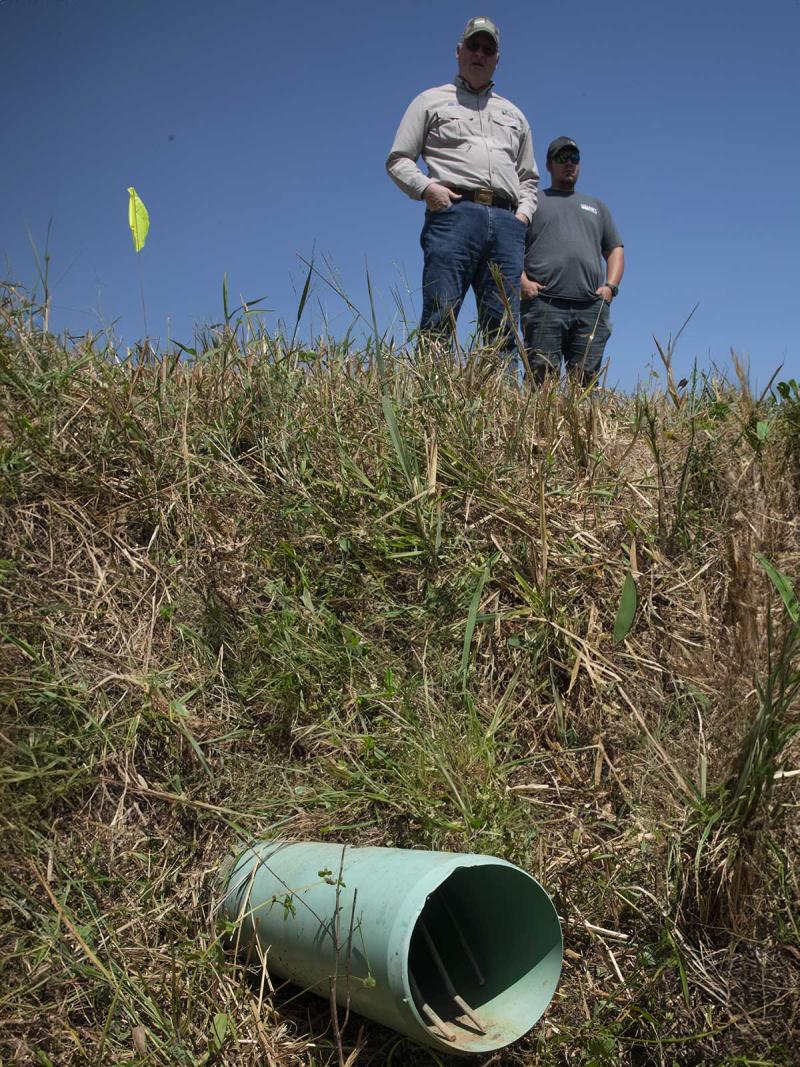
A common method to manage water in soil is to install tile drainage, which is corrugated plastic piping that is installed about 3 feet below the surface which is for lowering the water table. The plastic tubing is installed in the field in a way which drains to the lowest elevation in the field to an outlet. This can lead to salt being leached downward and into the tile lines. If the soil is sodic, water flows very slowly through the soil and does not reach the tile line due to a restrictive soil layer above the tile. The sodic layer in the soil is frequently about 6 to 18 inches below the surface in the B horizon, and the tile is installed below the layer that is sodic. Water usually does not flow through the impermeable sodic layer, and this leads to poor performance of the tile drainage. Also, engineers frequently suggest installing tile drainage at tight spacings, such as 30 feet between lines in low permeability soils, which is an expensive cost to the agricultural producer. Additionally, if soil salinity and sodicity levels are high, installing tile drainage can reduce the salt concentration, but the percentage of cations remaining in solution that are primarily sodium, leads to breakdown of soil structure and blocking of pores for water infiltration, resulting in a soil that is sodic with low hydraulic conductivity and therefor confounds the problem.
Using Vegetation to Improve Soils
Some plants are more effective at using water and have roots that go deep into the soil. Having roots go deep into the soil can use water deeper in the soil profile and create pores that water can flow through to allow more infiltration of water into the soil. This keeps the salt accumulation a few feet below the surface instead of at the surface. Also, these plants can uptake water that is slowly flowing towards the saline seep, reducing the amount of saline water that reaches the low spot where the saline seep is occurring. Plants that can be planted to do this include barley, alfalfa, tall wheatgrass, slender wheat grass, alkali grass, and Canada wildrye. Salinity tolerance of different plants grass species can be seen in Franzen et al., (2024). Producers in South Dakota have had success planting these species on saline and sodic fields. These plants reduce salt concentrations in locations where they are planted and keep the size of the saline and or sodic spots from increasing. When plants are grown that are inefficient at using water, more salts can move up to the soil surface and the portion of the field that has high salt levels near surface can increase. Converting land which was previously planted to salt tolerant grass species to a cropping system consisting of annual row crops can lead to an increase in soil salinity level at the location. This is due to more water moving up to the surface once salt tolerant species are no longer growing there.
In Summary
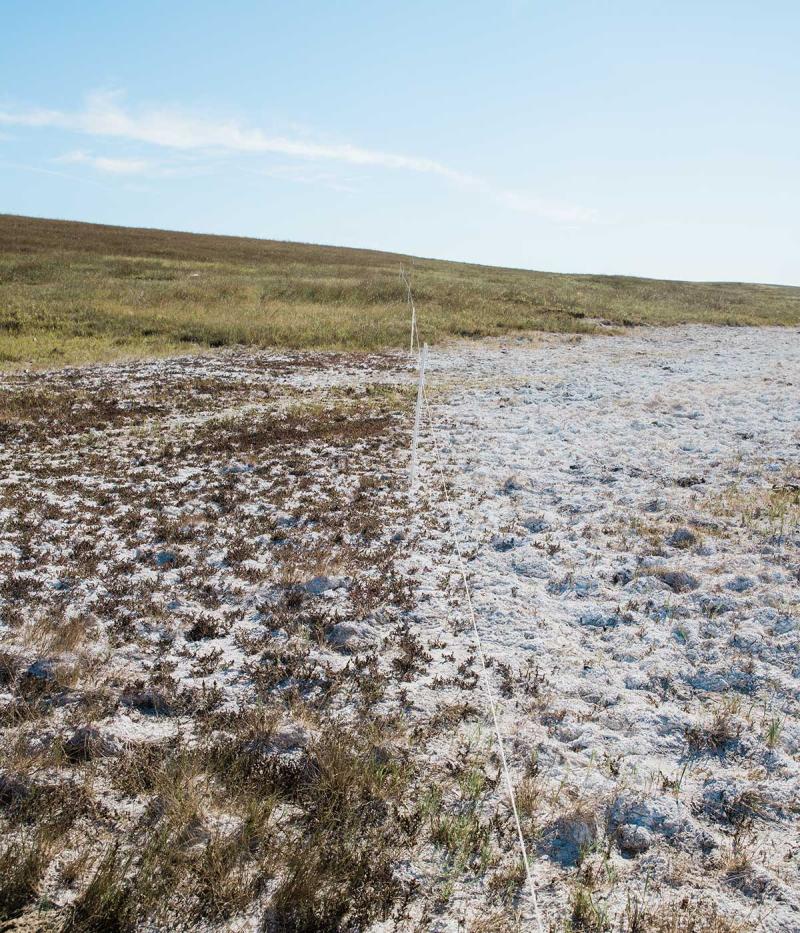
Salinity and sodicity are issues that negatively affect crop production and soil health in South Dakota. Types of issues related to salts present in soils include salinity, sodicity, and alkalinity. Saline soils have high dissolved cation and anion salt concentrations, which can contain a wide variety of positively and negatively charged ions. Saline soils generally have reduced plant growth due to difficulty of plants to take up water and nutrients when soil has high salt concentration. Sodic soils are soils with a high percentage of sodium cations in solution and absorbed to clays and do not have good soil structure and large pores for water infiltration. Sodic soils also usually have a high pH (>8.5) and low salinity levels. Saline-sodic soils have a high percentage of the cations in solution as sodium and a high salinity level. Removing salts from these soils without adding cations that improve formation of soil structure can lead to these soils becoming sodic. Salt levels present in the soil are frequently measured by measuring the electrical conductivity of the soil solution. Sodium levels in the soil are reported as the sodium adsorption ratio of the soil solution or the percentage of cations adsorbed to clays and organic matter that are sodium. Salts can be removed from the soil by improving the quality of irrigation waters that are applied and improving drainage. Sodium levels can be reduced by adding amendments to the soil that contain calcium and magnesium, and improving drainage, and/or also adding appropriate vegetation, such as salt-tolerant grasses. However, attempting to improve saline and sodic soils by improving drainage and adding amendments can cost a lot and may have poor return on investment. Also, in dryland agriculture in South Dakota, there is not enough annual precipitation to wash the salts downward in the soil over a few-year period.
References
- Brady, N.C. & Weil, R.R. 1999. The nature and properties of soils 12th ed.. Prentice-Hall Inc. Upper Saddle River, New Jersey.
- Carlson, C.G., D.E. Clay, D. Malo, J. Chang, C. Reese, R. Kerns, T. Kharel, G. Birru, T. DeSutter. 2015. Chapter 32: The Management and Identification of Saline and Sodic Soils in the Northern Great Plains. In Clay, D.E., C.G. Carlson, S.A. Clay, and E. Byamukama (eds). iGrow Corn: Best Management Practices. South Dakota State University.
- Davis, J.G., Waskom, R.M. and T.A. Bauder. 2012. Managing sodic soils. Colorado State University Extension
- Diaz, D.R. and D. Presley. 2017. Management of saline and sodic soils. Kansas State University Agricultural Experiment Station
- and Cooperative Extension Service Publication MF1022
- Grieve, C.M., Grattan, S.R., Maas, E.V. Plant salt tolerance. In: W.W. Wallender and K.K. Tanji (eds) ASCE Manual and Reports on Engineering Practice No 71 Agricultural Salinity Assessment and Management (2nd Edition), ASCE, Reston, VA Chapter 13 pp:405-409.
- Franzen, D., Augustin, C., DeSutter, R. & Kalwar, N. 2024. Managing saline soils in North Dakota, NDSU Extension North Dakota State University, Fargo ND, USA.

